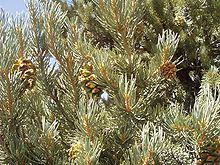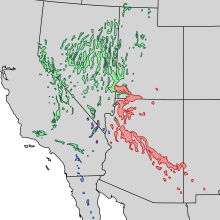| Single-leaf pinyon | |
|---|---|

| |
| Single-leaf pinyon (Pinus monophylla subsp. monophylla) leaves and immature cones | |
| Scientific classification | |
| Kingdom: | Plantae |
| Clade: | Tracheophytes |
| Clade: | Gymnospermae |
| Division: | Pinophyta |
| Class: | Pinopsida |
| Order: | Pinales |
| Family: | Pinaceae |
| Genus: | Pinus |
| Subgenus: | P. subg. Strobus |
| Section: | P. sect. Parrya |
| Subsection: | P. subsect. Cembroides |
| Species: | P. monophylla
|
| Binomial name | |
| Pinus monophylla | |

| |
| Natural range: green – Pinus monophylla subsp. monophylla blue – Pinus monophylla subsp. californiarum red – Pinus monophylla subsp. fallax | |
Pinus monophylla, the single-leaf pinyon, (alternatively spelled piñon) is a pine in the pinyon pine group, native to North America. The range is in southernmost Idaho, western Utah, Arizona, southwest New Mexico, Nevada, eastern and southern California and northern Baja California.
It occurs at moderate altitudes from 1,200 to 2,300 m (3,900 to 7,500 ft), rarely as low as 950 m (3,120 ft) and as high as 2,900 m (9,500 ft). It is widespread and often abundant in this region, forming extensive open woodlands, often mixed with junipers in the Pinyon-juniper woodland plant community. Single-leaf pinyon is the world's only one-needled pine.[2]
- ^ Farjon, A. (2013). "Pinus monophylla". IUCN Red List of Threatened Species. 2013: e.T42381A2976514. doi:10.2305/IUCN.UK.2013-1.RLTS.T42381A2976514.en. Retrieved 19 November 2021.
- ^ Gerry Moore et al. 2008
